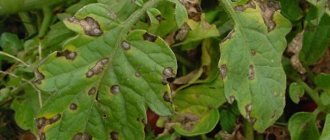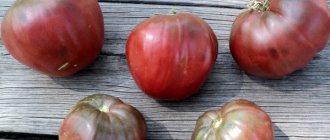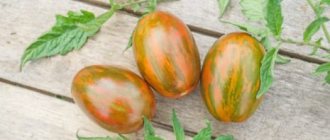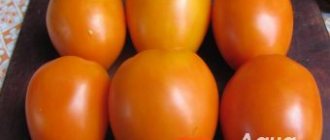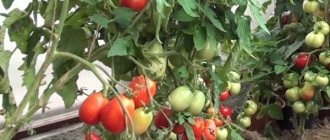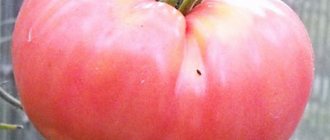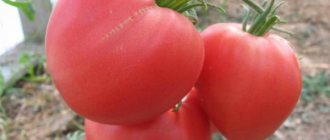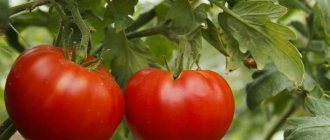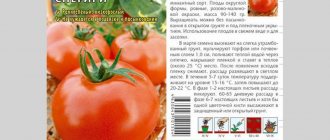Characteristics of tomatoes Swamp
Tomato Boloto forms a medium-sized bush of indeterminate type, growing up to 160 cm in height. The leaves of the variety are large and green. The first inflorescence appears above the 9th leaf, the next ones - every 3 leaves. Ripening time is 95 days from emergence.
The fruits of the variety are flat-round, some with pronounced ribbing. When unripe, they are green in color with a dark green spot on the stalk. A ripe tomato is yellow-green, green inside, maybe interspersed with pink. The weight of the fruit is from 150 to 250 g, the internal structure is multi-locular.
Tomato Swamp on video
If you grew Boloto tomatoes, please write whether you liked them or not. What was the yield and taste of the fruits like under your climatic conditions? If possible, attach to the comment a photo of the entire bush as a whole or individual fruits that you grew. Thank you!
Your feedback on the Boloto tomato, as well as additions to the description, will help many gardeners evaluate this variety more objectively and decide whether it is worth planting or not.
This is a natural variety of tomato. Therefore, we recommend taking seeds from a ripe fruit and using them for planting in subsequent seasons.
Pros and cons of the tomato variety Swamp
Boloto variety tomatoes are grown for their unique taste and green-yellow color. Green-fruited tomatoes are especially suitable for those people for whom red varieties are contraindicated for medical reasons.
Other advantages of the variety:
- early ripening;
- good yield;
- high content of vitamins.
The disadvantages of the variety include poor keeping quality and transportability due to the thin skin of the fruit. It is also difficult for some gardeners to determine the degree of ripeness of tomatoes due to their color.
Pest and disease control
To prevent late blight and other fungal diseases, immediately after transplanting Swamp tomatoes into open ground or a greenhouse, summer residents treat the bushes with a fungicide (one to choose from):
- "Fitolavin";
- "Ordan";
- "Farmayod";
- "Profit";
- Bordeaux mixture.
If pests appear on the bushes, they can be dealt with using folk remedies, for example, a solution of wood ash, an infusion of onion peels, chopped garlic, and dry mustard powder. If they do not give the desired result, it is recommended to use insecticides:
- "Aktara";
- "Biotlin";
- "Decis";
- "Fufanon";
- "Confidor"
Important! When growing Swamp tomatoes in open ground, treatment is carried out in dry and windless weather. Harvesting can begin no earlier than in 5-10 days.
Growing in open ground
In open ground, as in a greenhouse, the Boloto tomato is grown through seedlings. To do this, seeds are sown in late March - early April. Seedlings are planted in open ground at the age of 60 days, in late May - early June. To grow tomatoes in open ground, it is necessary to install temporary shelters to protect the plants from possible cold snaps, as well as shading on hot days.
Growing seedlings
Before planting, seeds are disinfected in a solution of fungicide or hydrogen peroxide. It is best to grow tomato seedlings in peat tablets of the largest size. This substrate is lightweight and friable, necessary for successful germination, and also contains the necessary nutrients.
Before germination, peat tablets with seeds are kept in a mini-greenhouse - a container with a lid. After the first seedlings appear, remove the lid and move the container under lamps with a special spectrum.
Advice! In the first 3-4 days after germination, tomato sprouts are exposed to light for a full day.
As soon as the roots of the plants sprout and are visible from the bottom of the peat container, the seedlings, without removing the peat tablet from the shell, are transplanted into a larger container with a volume of 0.5 liters.
After picking, the plants are spaced freely so that their leaves do not touch and excessive stretching of the stems does not occur.
Landing rules
Grown seedlings are transplanted into heated soil when constant air temperatures at night are above +12°C. The bed for planting is prepared in advance; the soil must be treated from pests, freed from weeds and well loosened.
A hole is dug to the size of the earthen ball in which the seedlings grew. The hole is watered abundantly, fertilizer is added, and it is mixed with the soil. Plants are transferred to the ground using the transshipment method. Tomatoes tolerate transplantation well, but at first they need to be shaded. Watering after planting begins only 10 days later, which allows the plants to take root well.
Watering and fertilizing
When watering tomatoes, it is important not to allow the soil to dry out or become waterlogged. Watering should be leveled with heated water. It is best to use a drip system.
Important! Watering with large amounts of water after a long break leads to cracking of the fruit.
The first fertilizing is applied a week after the plants take root and begin to grow in their permanent growing location. Further feeding is carried out every 2 weeks. It is best to use liquid organic fertilizers, for example, infusions of mullein, grass, yeast and ash.
Pinching and tying
A tall tomato must be regularly pruned - remove the side shoots that do not form a full cluster of flowers, but take up a lot of nutrition and moisture. Stepchildren grow between the stem and leaf. They are broken off or trimmed with a clean tool, leaving a stump of 1 cm, which prevents re-growth.
To grow a Bog tomato, you need to install a support for gartering the stems. The bushes begin to be tied up immediately after transplanting into the ground. To do this, use twine, which is tied with a loose loop on the bottom of the plant. Then the twine is wrapped around the stem and secured on top of the support. Later, as the Boloto tomato grows, it continues to be twisted in a spiral around the twine.
Formation
According to the description of Swamp tomatoes, the plant is recommended to be grown in one stem. To do this, leave one central stem and flower brushes, the remaining side shoots are completely removed.
When forming the stem, not only the stepsons are removed, but also the spent leaves. Once the fruits on the very first flower cluster begin to ripen, the need for lower leaves decreases. Therefore, they are gradually cut off, preventing them from drying out on their own and coming into contact with the soil, which can provoke the occurrence of fungal diseases. To prevent plants from experiencing stress, remove no more than one leaf per week.
Important! Gradual exposure of the stem allows the plants to be well ventilated and not shade the fruits, which need a lot of sunlight to ripen.
At the end of summer, the top of the plant and all the upper peduncles are cut off. The fruits on such clusters will not have time to appear, but the plant spends energy on their development. Pinching the top allows you to speed up the ripening of already formed fruits.
Protection from diseases and pests
According to reviews and photos about Swamp tomatoes, the plant is susceptible to typical nightshade diseases. One of the most common diseases of tomatoes is late blight, which appears from the soil and spreads to the plant through the vegetative mass. Therefore, mulching the soil, removing spent leaves and airing can significantly reduce the risk of fungus development. When late blight appears, the biological product “Fitolavin” is used.
At the beginning of the season, greenhouses and the soil in which the insect overwinters are treated against the appearance of a pest such as whitefly. For disinfection at the beginning of the season and when a pest appears, spraying with a Farmayod solution is used. After treatment, microbiological preparations must be added to the soil to restore the balance of beneficial bacteria.
When various leaf-eating and leaf-sucking insects appear, the broad-spectrum insectoacaricide “Fitoverm” is used. The drug is used only for treatment, prevention is not carried out with it.
Features of cultivation
Growing is recommended in beds where cucumbers, cauliflower, and carrots were previously grown. The variety does not cause much trouble when growing. Needs periodic watering with warm water in the evening, removing weeds, loosening the soil in the holes. It is also necessary to fertilize the plants with mineral fertilizers 2-3 times.
A slight increase in yield is facilitated by spraying the bushes with Epin-extra.
Main use of the variety
Tomatoes of the “Swamp” variety are consumed in fresh salads, with herbs and tomatoes of other colors. Stronger, slightly unripe fruits are suitable for canning, since ripened fruits may crack during processing.
The variety is not suitable for long-term storage due to rapid spoilage of the fruit.
Tomato for your health
The fruits of this tomato variety ripen in about 100-105 days, that is, Dietary Healthy is a mid-early variety.
It is part of the group of determinate tomatoes, and it definitely needs shaping, staking and pinching. The height of the bush reaches about one and a half meters (in a greenhouse), in open ground it can be lower - 80-100 cm. Medium height, foliage is also average. The leaf is simple, the color is rich green. The fruits of the Dietary Healthy are interesting and beautiful - dense, orange-yellow in color. On average, their weight is up to 300 grams, but you can get tomatoes up to 500 grams.
The pulp is also dense, fleshy, there are few seed chambers and seeds. The taste is excellent, and this is noted by everyone who has tried to grow the variety. The aroma and special sweetness are also noted. These tomatoes are great for cutting into salads and for juice. Can be used in dietary and baby food.
ON A NOTE! The peculiarity of the fruits of the Dietary Healthy variety is a high content of carotene and a small amount of acids.
The fruits have good keeping quality and are suitable for transportation.
Tomato care
There are no particular difficulties when growing tomatoes of this variety. They are quite unpretentious.
Important! The best soil for planting “swamp” tomato seedlings in a permanent place is soil in which carrots, cucumbers, and cauliflower grew before tomatoes.
Feeding and watering
The “swamp” variety loves moisture very much, so it will not be superfluous to water the plants every day, especially in the first time after planting in the ground. Then watering with warm water once every few days will be sufficient. The main thing is that there is no significant stagnation of water.
Like any other tomatoes, this variety needs feeding. It should be carried out several times during the period of full maturation. Both organic and mineral ready-made fertilizers are suitable. You can fertilize with nitroammophoska a couple of times, after watering the plants; after fertilizing is completed, you should water again.
The following mixture is suitable as a fertilizer: 1 bucket of a solution of chicken manure in water (1:15) + ash (300 g) + superphosphate (50 g). Spraying plants with Epin-Extroy promotes more productive planting and increased yield. Copper and sulfur in the fertilizer help prevent fungal infections of plants.
Did you know? Red tomatoes have more nutrients than yellow ones.
Bush formation and pinching
Tomato bushes of the declared variety require formation and infrequent pinching. For maximum productivity in the future, it is recommended to form plants into two stems. It is better to start the process when the tomato is completely strong and has already begun to grow. You need to pluck the shoots from the first cluster with flowers that appears (once the shoot reaches a length of 5 to 7 cm).
The most suitable time of day for this is the morning without precipitation. “Swamp” tomatoes need to be planted infrequently - 2-3 times during the entire period of their cultivation. When the tomato bushes reach the desired height, the lower leaves are removed.
Did you know? Almost 95% of the mass of a tomato is water.
Loosening the soil
The soil around the tomato bushes should be systematically loosened. This is necessary to improve the supply of oxygen and moisture to the root system. It is especially recommended to do this after watering to avoid crust formation. Loosening should not be deep, as damage to the roots is possible (a few centimeters deep will be enough). Weeds that appear during loosening are also removed
Harvest and storage
When starting to pick tomatoes, you need to remember:
- they must be picked from the bush before the temperature drops below +8°C, otherwise they will spoil very quickly;
- It is better to collect fruits during the day when there is no dew;
- tomatoes should be sorted;
- When harvested, tomatoes wiped with a cotton wool soaked in vodka or alcohol are disinfected and stored longer.
To extend the shelf life of tomatoes, the following conditions must be provided:
- the room where they are stored should be dark and cool;
- optimal temperature - from +5 to +12°C, air humidity - 80%;
- tomatoes should be carefully placed in containers made of wood or plastic with the stems facing up;
- Unripe tomatoes last longer.
Did you know? Unripe tomatoes have one toxic component - solanine.
“Swamp” tomatoes are interesting and unusual. This becomes the reason for disagreement on the question of whether they are worth growing. But those who tried to do it did not regret it. These tomatoes are tasty, easy to care for, and due to their exotic appearance they can become a decoration for any dish, and the harvest fully satisfies the demand of gardeners.
Advantages and disadvantages
The Boloto tomato is a new product; it appeared on the market not long ago, but has already firmly gained popularity among many gardeners.
The advantages of the Boloto variety include:
- unusual appearance;
- good taste;
- early fruit ripening;
- high productivity;
- stable fruiting in conditions of high humidity.
Numerous reviews say that growing tomatoes, even in the absence of specific knowledge, is not difficult. It is unpretentious in the choice of soils and does not require special additional care. The characteristics of the variety indicate a number of disadvantages. Gardeners note sensitivity to transportation and short storage. The fruits wrinkle easily and lose their presentation.
general description
The variety is new. It was created by breeders from Russia. It is best to grow bushes in greenhouse conditions or under film. You can also grow “Swamp” outdoors, but only in those regions closer to the south. The variety bears fruit early and has a very unusual tomato color. Tomato has both positive and negative characteristics.
In general, reviews from summer residents about the “Swamp” tomato are very different. Some people praise it for its good taste, others think that the variety can be planted 1-2 times for variety, but no more. The fact is that fruits cannot be stored for a long time, transported over long distances, and require special care. Most often, “Swamp” is planted precisely because the fruits look exotic.
